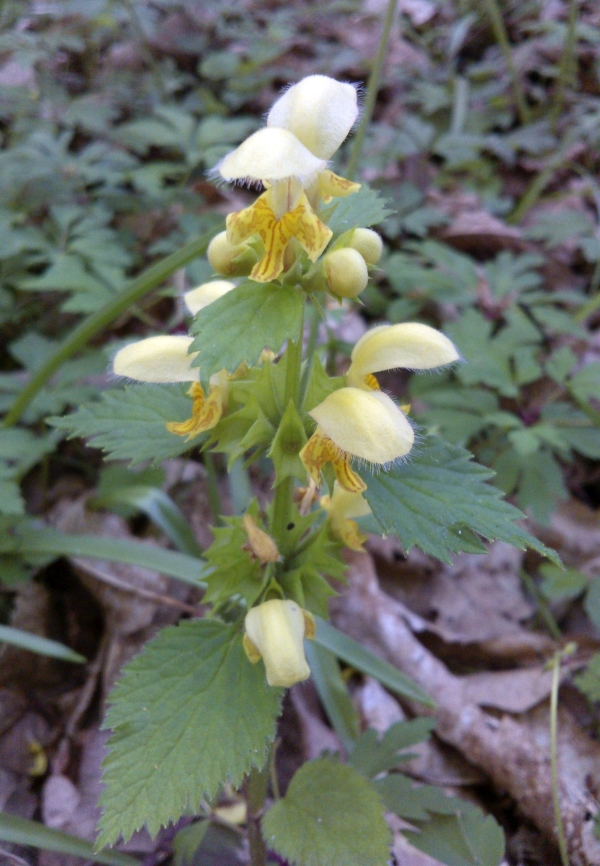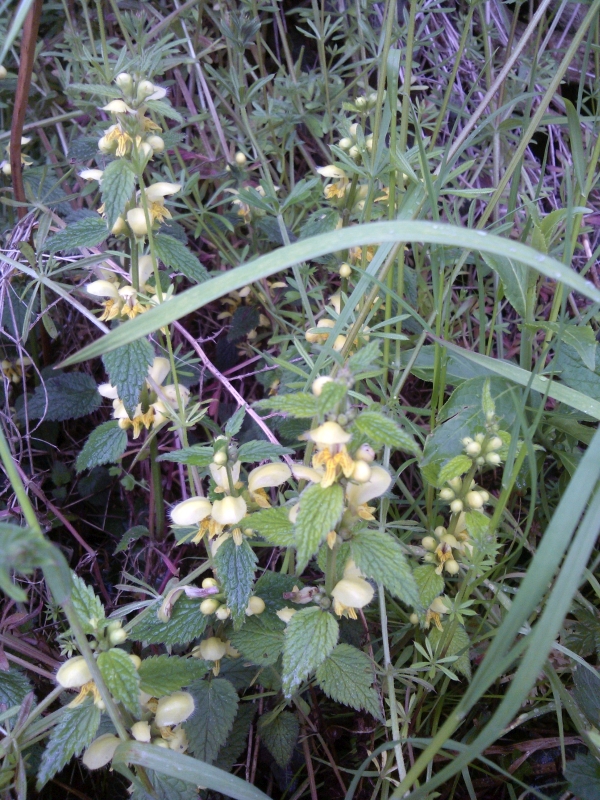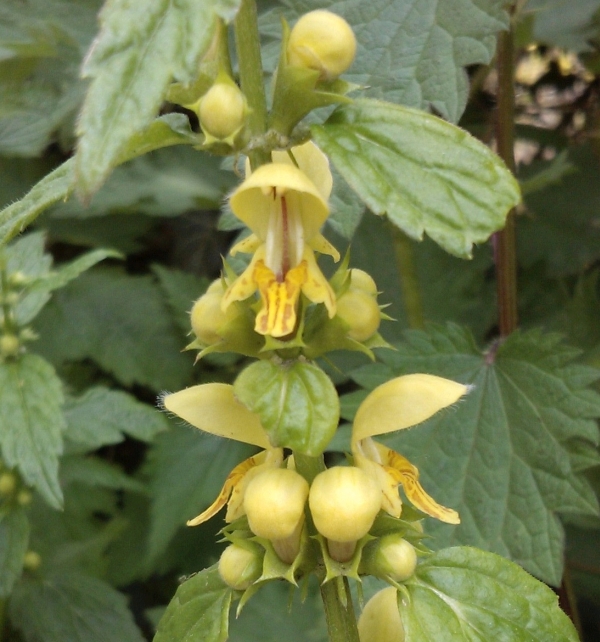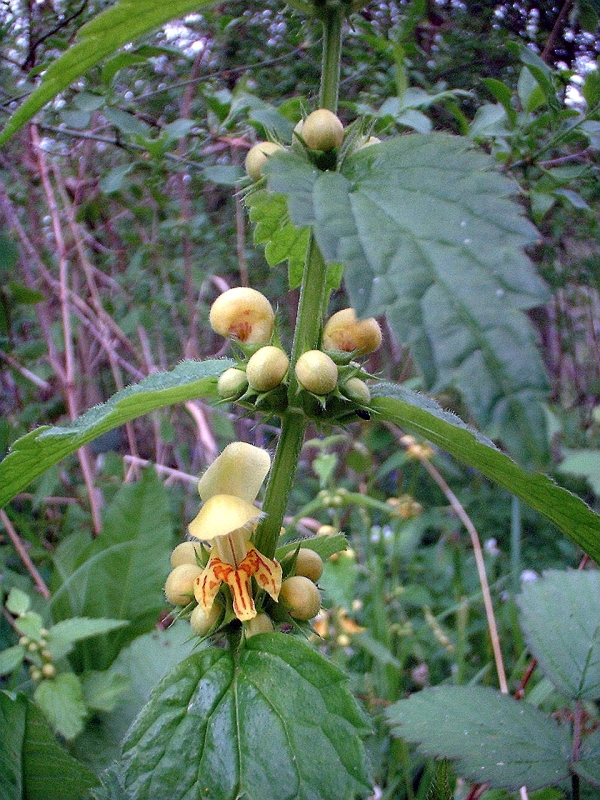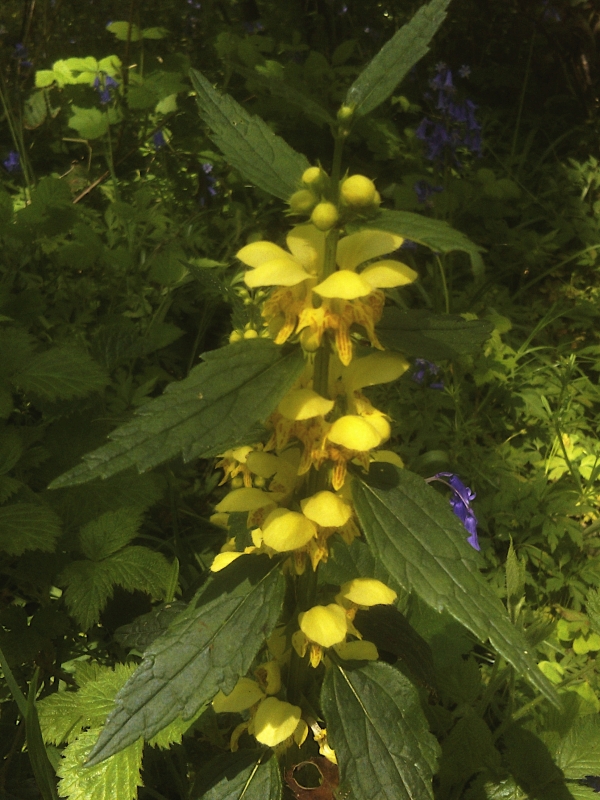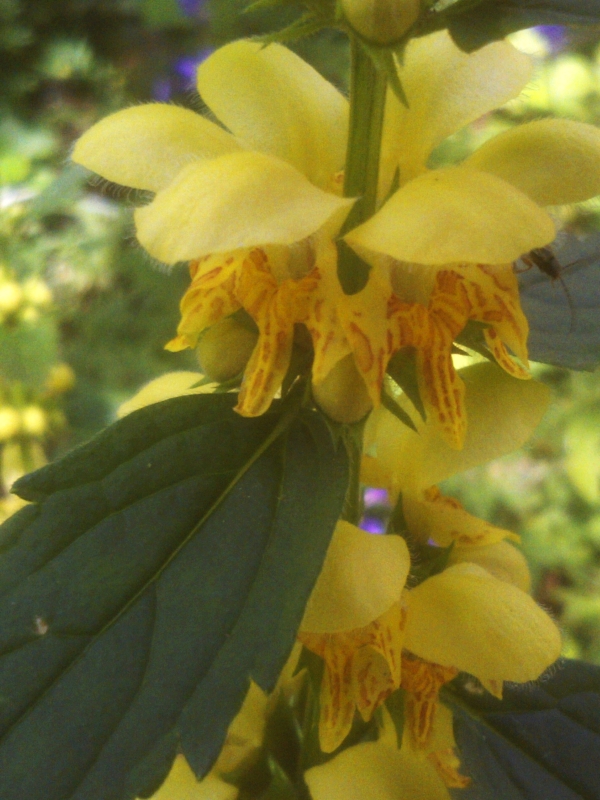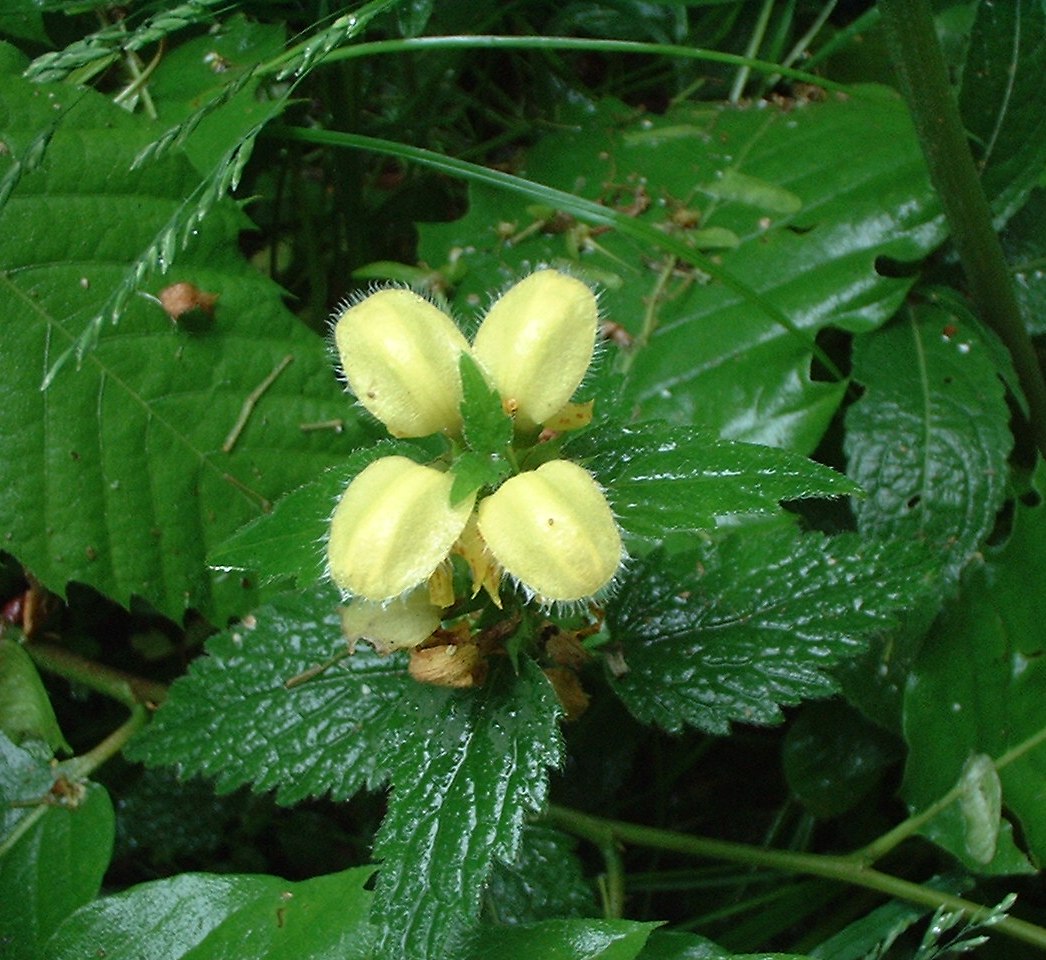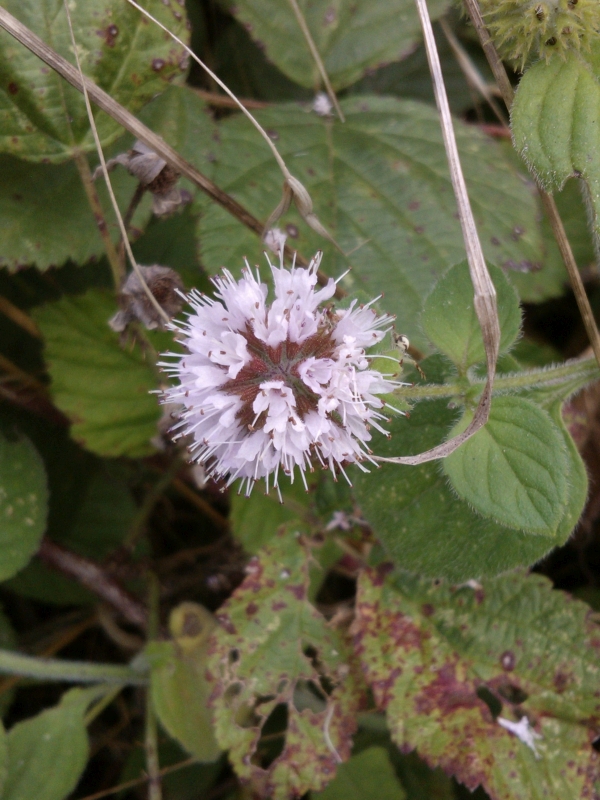More
Lamiaceae
Lamiastrum (Lamium) galeobdolon (Yellow Archangel)
Lamiastrum galeobdolon (Lamium galeobdolon) or Yellow Archangel is a perennial herb found in woods and on hedge-banks, preferring calcareous soils. It occurs in Europe, parts of North America and some other parts of the Northern Hemisphere. It shares many features in common with Lamium with which it is sometimes classified, including 4 anthers in two pairs beneath the hood of the upper lip of the corolla. The greenish calyx tube of sepals at the base of each flower also separates into 5 teeth, which are spreading and pointed. The leaves are stalked with slightly cordate (heart-shaped) bases and ovate or deltoid-ovoid in shape (egg-shaped and slightly triangular in contour) with leaf blades up to 6-7 cm in length. The leaves grade into leaf-like bracts on the flowering stems (shown above) which are narrower with shorter stalks and usually become narrower towards the top of the flowering stem.
The corolla (partially fused petals) is yellow and up to 2.5 cm in length. The upper lip forms a vaulted roof over the 4 stamens and is somewhat hairy. We can speculate about the function of such hairs on petals and one possibility is that they provide a water repellent surface, keeping the petals clean and free of dirt and water to maintain the display to attract pollinators. They may also deter certain insects from feeding on the petals. The lower lip is a more vivid yellow and is divided into three lobes, the middle lobe being slightly larger than the two laterals. It is decorated with red-brown spots and streaks that likely act as signals to attract and guide pollinators. The flowers are arranged in whorls or verticillasters of 6 to 10 flowers. The forked style can be seen just above the lower surface of the anthers (above).
The flowers are pollinated by certain bees with a long enough proboscis to reach the nectar secreted from the disc nectary at the base of the ovary, such as honeybees. certain other bees may steal the nectar by making a hole in the corolla tube and hence fail to bring about pollination. When the flower is in its first male stage the paired stigma is held high up, just above the anthers, and if the bee pushes hard against the stigmas then the stigmas will contact the insect away from the region of its back where the anthers deposit pollen. Each anther has two pollen-producing locules which are joined at the apex and which open to release pollen via a common longitudinal slit. Later on, when the anthers are spent and the flower is in its female stage, the stigma moves down to easily brush the back and remove pollen from any visiting insect. This helps ensure cross-pollination. Failing this, flowers can then proceed to self-pollinate.
Typical of Lamiaceae the fruit are four small nutlets or nucules, each containing a single seed and each equipped with an elaiosome. The elaiosome secretes oils that attract ants which carry away and store the seeds, promoting their dispersal and germination. The nucules are reported to be often abortive/infertile in the British Isles (Syme, 1867 in English Botany) and Packham (1983) reports that they are slow to ripen with few reaching maturity (more so in warm and dry summers more typical of southern England) but that nevertheless seedlings are produced in abundance.
The flowering stems root at the base but are otherwise erect or ascending and reach some 20 to 60 cm in height. The rootstock is very short and creeping and puts out multiple stems and many fibrous roots. Flowering stems appear over Spring/Summer but in autumn the rootstock puts out non-flowering leafy stems (stolons) that trail along the ground for 30 to 60 cm, up to 1 meter or more, rooting at the nodes (and hence affecting vegetative propagation). After flowering the flowering stem often collapses to the ground and grows along it (presumably shedding nutlets where ants can find them?). The stolons are wintergreen.
The margins of the leaves and also the leafy-bracts are either irregularly crenate (having small roundish teeth) or serrate (having teeth shaped like those on a saw edge) often doubly so. Many leaves of plants have similarly indented margins which begs the question of the function of such marginal teeth. The only function I can think of is that the marginal points allow easy water runoff from the surface of the leaf. Keeping the leaf free of water and debris is important to maintain optimal photosynthesis, so leaves are self-cleaning, aided by the water-repelling waxy cuticles they secrete. Water is more likely to drip from a point as this reduces the contact between the adhesive water and the surface, allowing drops to form. In many plant species the points on the leaf margin occur where leaf veins terminate and these may function as hydathodes or water-secreting glands that maintain transpiration in high humidity where evaporation is limiting. Locating hydathodes at the end of leaf marginal teeth allows a droplet to form easily and fall clear of the leaf.
The classification of Lamiastrum has been addressed with molecular data (see: Ryding and Thorbek, 2001). The conclusion is that based on molecular data Lamiastrum could equally be grouped with the genus Lamium or kept as a separate genus. Lamiastrum is a sister group to Lamium and the two diverged early on and both genera would make monophyletic groups whether kept separate or combined into a single monophyletic group. A monophyletic group is a group that includes all the descendants of the its root species and no other and is therefore a discrete evolutionary group for taxonomic purposes.
Note that the anthers are not hairy as they are in Lamium album.
The specimens photographed here occurred in Kent, England, British Isles and all belong to subspecies. montanum.
Note that the anthers are not hairy as they are in Lamium album.
The yellow archangel, Lamiastrum galeobdolon, has an
interesting biology. Most forms can reproduce asexually by means of
stolons or suckers (a horizontal shoot which roots at intervals to
produce new plants) which run either beneath the ground or along it and
which may bear leaves. Three main subspecies are naturally occurring in
Europe: subspecies montanum, galeobdolon and flavidum.
In the British Isles only montanum and galeobdolon occur
naturally, flavidum (which unlike the others does not form
stolons) occurs in mountainous regions on continental Europe, such as
the Central and Eastern Alps. In the 1980s another subspecies, Lamiastrum
galeobdolon ssp. argentatum escaped from horticulture and
became naturalised and is now the most widespread in Britain and
Ireland, occurring in most regions. Montanum is quite widespread
in england and Wales but very scattered in Scotland. It grows in
woodlands and hedges, apparently preferring woodland edges to deeply
shaded areas and occurs in beechwoods on limestone, and in oak-ash woods
along with Bluebell (Hyacinthoides non-scripta), anemones, arums,
primulas, Ajuga reptans (Bugle), Dog's Mercury and Wood Sanicle.
Subspecies argentatum, also known as variegated yellow
archangel, has 'variegated leaves' which actually have colourless
regions which contain air pockets (these are much less frequent in the
other subspecies). This invasive form was bred from native European
forms. Telling subspecies montanum and galeobdolon apart
is not so easy. Subspecies galeobdolon is diploid (it has two
copies, 2n, of n chromosomes) with 18 chromosomes (n = 9) whereas montanum
is tetraploid (4n) with 36 chromosomes. Montanum is more
vigorous and is generally a taller plant at 20-60 cm compared to 15-45
cm for galeobdolon and more flowers per whorl (more than 8
compared with less than 8) and more whorls per inflorescence (4-7,
sometimes 3-10, compared with 2-4, sometimes 5). The upper bracts and
stolon leaves of subspecies galeobdolon tend to have more
crenate (rounded) teeth whereas the teeth tend to be more serrate
(pointed) in montanum. However, all these characteristics
overlap, a montanum growing in poorer conditions may resemble galeobdolon
in vigour. However, a study by Wegmuller (Wegmuller, S, 1971. A
cytotaxonomic study of Lamiastrum galeobdolon (L.) Ehrend. &
Polatschek in Britain. Watsonia, 8: 277-288) showed a good
separation of the two if one considers stomatal length together with
bract length to width ratio (l/w): ssp. galeobdolon has a bract
l/w of about 0.9 to 1.8 and a stomatal length of 24 to 28 micrometres; montanum
has a bract l/w of 1.4 to 4 and a stomatal length of 28 to 36
micrometers.
It has been suggested that ssp. montanum is a hybrid of ssp. galeobdolon
and ssp. flavidum as its characteristics are intermediate. This
would make it an allotetraploid - a tetraploid with two
chromosome sets from one species (or subspecies) and two from another.
Ssp. argentatum was favored by gardeners partly because it
easily spreads forms dense leaf cover. Although it does not set
seed it reproduces rapidly by stolon formation. this characteristic
makes it a potential threat as an invasive alien species, a potential
problem being investigated by prof. Ian Rotherham of Sheffield Hallam
University, UK.
Lamiastrum galeobdolon is a perennial with a shortly creeping branching ('many headed') rootstock. Very long vegetative shoots (the stolons or runners) are trailing or arching and develop roots. The flower stems are non-rooting and erect or ascending and up to 60 cm tall. The leaves are stalked and each verticillaster consists of 6 to 10 flowers. The lower bracts resemble the leaves but are narrower with shorter stalks, whilst the upper bracts become more lanceolate (shaped like the head of a lance) with wedge-shaped bases rather than definite stalks. The corollas are bright yellow with distinctive orange markings (presumably nectar guides). The upper lip also expands into a prominent vault. These features give these plants a very striking appearance. It is not clear whether they produce viable seed in the British Isles (Syme, 1867, described the fruit (nucules) as 'abortive') where they are more abundant in the south of England (ssp. montanum, with the less common ssp. galeobdolon occurring in a few scattered sites further north, e.g. North lincolnshire).
This species occurs in woods and along hedge-banks, especially on chalk and limestone soils. (The brilliance of the yellow corollas combined with their tendency to grow in shaded habitats can make photography of this species challenging). A specimen in full bloom can be spectacularly beautiful.
As in some species of Lamium, such as Lamium album, there is an inner ring of angled hairs inside the corolla tube, protecting the nectary. Lamiastrum galeobdolon has a similar ring of such hairs. Note that the middle lobe of the lower lip ends in a single point. The teeth on the calyx are short and roughly triangular in shape.
Mentha aquatica (Water Mint)
Article updated: 7 May 2022.
